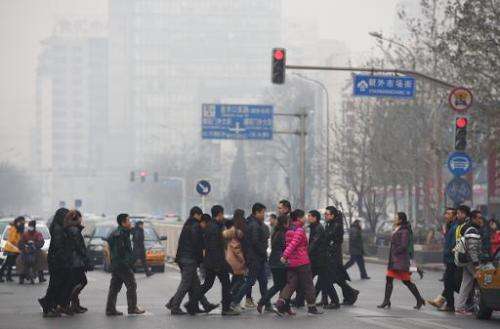China air quality dire but improving: Greenpeace

The skies of China's notoriously smog-filled cities saw a marginal amelioration last year, according to figures released by Greenpeace Thursday, but pollution remained far above national and international standards.
China's cities are often hit by heavy pollution, blamed on coal-burning by power stations and industry, as well as vehicle use, and it has become a major source of discontent with the ruling Communist Party.
Retired senior officials have acknowledged that it may kill as many as half a million people a year.
Levels of PM2.5—airborne particulates with a diameter small enough to deeply penetrate the lungs—fell year-on-year in 71 of the 74 cities monitored by the ministry of environmental protection, the figures showed.
But in China's most polluted city, Xingtai, they still averaged 131.4 micrograms per cubic metre. In Beijing, they were 83.2 micrograms per cubic metre, and 52.2 in Shanghai, the country's financial centre.
By comparison, New York's PM2.5 level averaged 11.2 last year and Tokyo's was 15.8 for the fiscal year ending in March 2014, the most recent figures available.
The World Health Organization recommends a maximum average exposure of 25 micrograms per cubic metre in a 24-hour period, and 10 micrograms per cubic metre over a year.
China's own standard is 35 micrograms per cubic metre over a year.
The statistics released by Greenpeace were based on official data from China's ministry of environmental protection.
It makes current levels available online but does not publicly release historical data or averages. The figures were compiled by Fresh-Ideas Studio, the operator of a popular pollution monitoring app.
The numbers showed that Xingtai, in the northern province of Hebei, enjoyed a 15.3 percent improvement, with Beijing levels falling 7.7 percent and Shanghai dropping 14.0 percent.
Xian, home to the Terracotta Warriors, saw the most dramatic decline at more than 27 percent.
But despite the drops none of the 74 cities achieved the WHO recommended annual mark, with the least polluted, Haikou on the island of Hainan, averaging 22.4.
A touch of smog
The environmental campaign group also released a short film on the subject by renowned director Jia Zhangke, whose prize-winning 2013 movie "A Touch of Sin" was denied a Chinese release by the country's censors.
"Smog Journeys" tells the story of two families, one in China's coal belt and the other in Beijing, showing how neither wealth nor education can defend against smog. It closes with a child in Beijing drawing pictures on dust-covered cars of a world he hopes to live in, complete with a radiant sun.
"The character setting is meant to point out that no one gets to be different when it comes to smog," Jia said in an interview posted by Greenpeace on YouTube.
"One thing that fascinated and shocked me the most was the fact that even on smoggy days, people still live their lives as usual."
Public discontent about the environment has grown in China, leading the government to declare a "war on pollution" and vow to reduce the proportion of energy derived from fossil fuels. But it has shied away from pledging to cut total national coal use.
One factor contributing to the decline in parts of northern China is likely to have been the car use restrictions, factory closures and public-sector holidays imposed during a November meeting of the Asia-Pacific Economic Cooperation (APEC)forum in Beijing.
The result was stunning skies popularly dubbed "APEC blue" by online commentators mocking their temporary nature, and even Chinese President Xi Jinping himself used the phrase in a speech.
Pollution is a perennial issue on Chinese social networks, with users on Thursday poking fun at efforts by officials in the southwestern city of Chongqing to clean up dirty air by banning residents from smoking bacon, a traditional method of preserving pork—the latest scientifically dubious theory about its cause.
Environmental activists called for further steps to reduce pollution, cutting coal use and shifting towards renewables. "Clean air is a basic necessity for healthy living," said Yan Li, Greenpeace East Asia's head of climate and energy.
"It's sad if children grow up with more smog than clean air and blue skies, as depicted in Jia's film. Bringing back clean air needs to be a priority and it requires urgent action."
In a commentary piece for the Lancet, a leading medical journal, China's former health minister Chen Zhu and environmental officials said "that between 350,000 and 500,000 people die prematurely each year as a result of outdoor air pollution in China".
© 2015 AFP



















